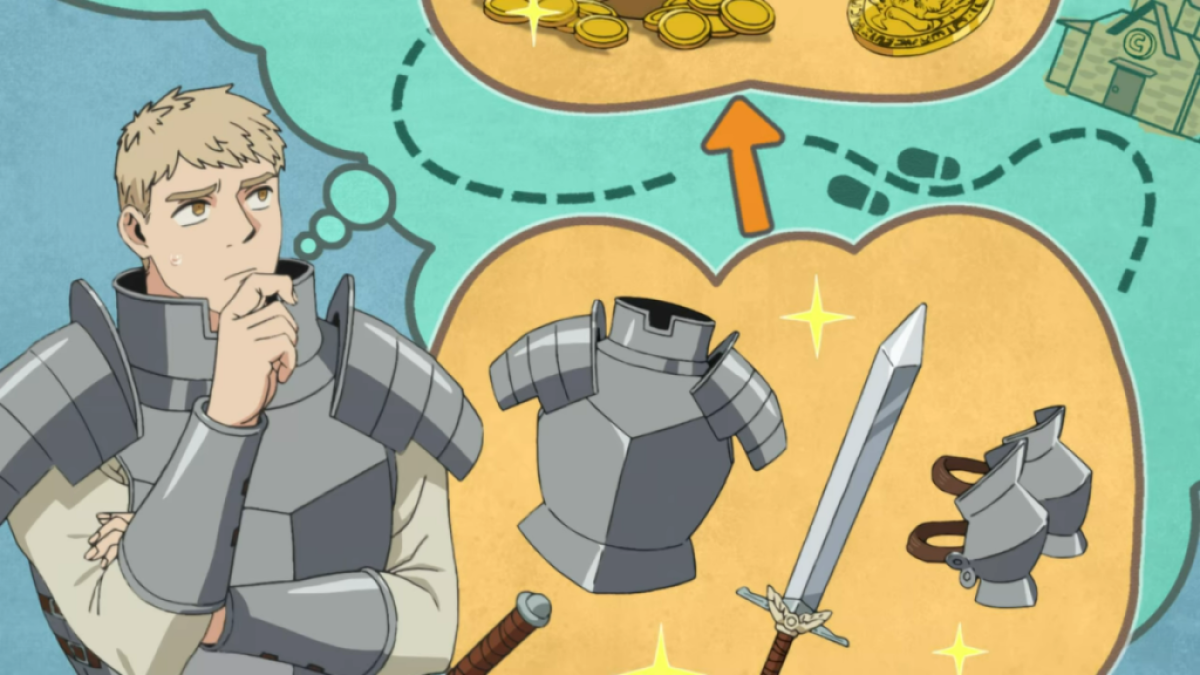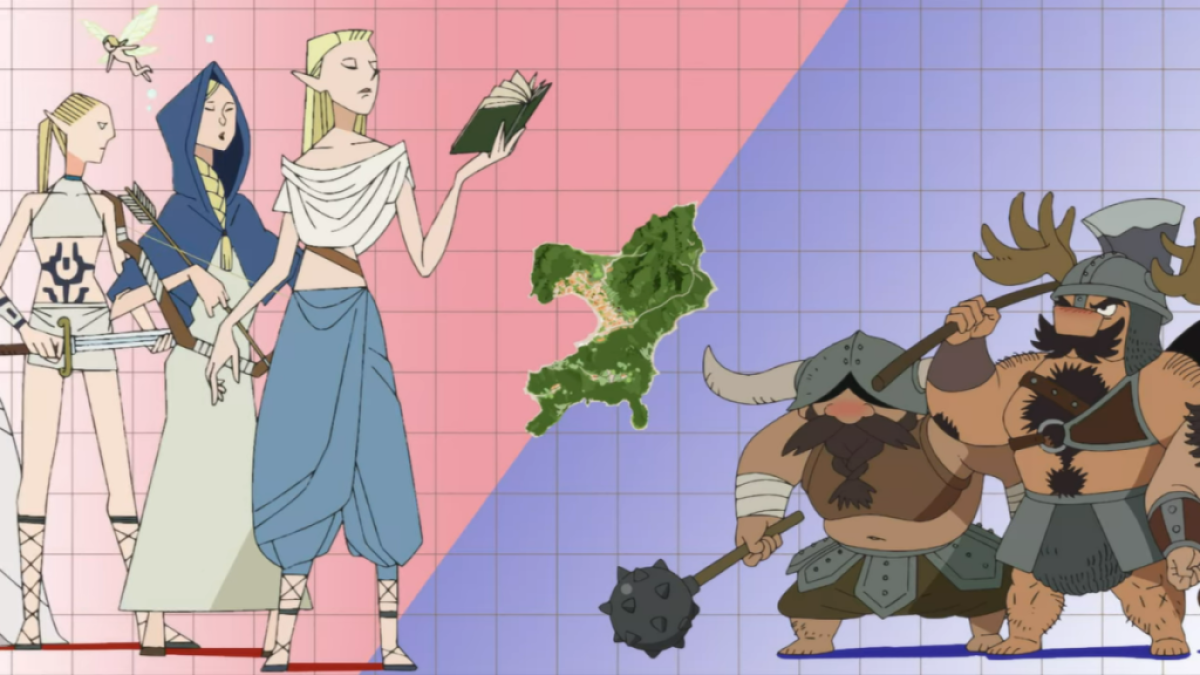At first glance, the setting of Delicious in Dungeon, or Dungeon Meshi, can seem a tad plain. It may look like an accessible, if generic, blend of Tolkein, Dragon Quest, and Sword World. But sometimes the most important part of a dish may not be the most overpowering flavor, but a subtle texture or memorable aftertaste. So too is the strength of Delicious in Dungeon, as it is found not in the high concept or even in the novelty of fantasy food, but in the care and attention to detail shown in its worldbuilding.
Editor’s Note: The following contains discussion of the Delicious in Dungeon anime up to episode 16, as well as some allusions to events in the manga, and as such contains spoilers.
Even though the story starts with a very classical fantasy set up, there’s groundwork being laid. If you’ve ever played Dungeons and Dragons or any number of other roleplaying games, you’ve likely had to decide whether you’re actually going to make use of the rules governing supplies and logistics, keeping track of how many arrows your archer has fired and so on. Many players skip them and count it all as being done off-screen, so as not to ruin the flow of play. But in Delicious in Dungeon, logistics is a key part of the set up for the journey. In fact, the whole reason Laios and co. resort to eating monsters is the lack of money for proper supplies.

A significant section of the first episode of the anime is devoted to discussing the logistics of what is sometimes called a “corpse run,” a journey back to where you previously died in order to reclaim your items (and in this case, Laios’ sister Falin). It skips the minutiae, as there is no counting arrows or individual rations, and instead gets to the interesting aspects that require real decisions. Do they downgrade their equipment to secure supplies, or downsize their party further and rely on stealth? It emphasizes that despite the simple designs and accessible setting, this is a story where the material aspects of dungeoneering are fully considered, and that lends a weight to those decisions.
This weight, of course, impacts other areas. The demand for supplies and weapons, combined with the riches gleaned from the dungeon, has driven the development of the surrounding town. What was once a village on an unassuming island has become a major trade hub, with all the clamour and politicking that comes with so many people with different interests in one place. Episode 10 cuts away from the main party to outline just some of the maneuvers going on behind the scenes, from the Elf-Dwarf territorial disputes to Tansu and the lord of the island planning to incentivize further adventuring expeditions for their own ends.

Now, inter-species hostilities are hardly new to fantasy, but it’s the way Delicious in Dungeon shows how people’s perceptions inform not just the wider geopolitical landscape, but also the relationships between characters of different backgrounds. Early on this is played for laughs like when Senshi, who hasn’t encountered many half-foots before, treats Chilchuck like a child. But later chapters of the manga only expound upon this, as more elven characters get involved and we see that arrogant, paternalistic attitude complicate the situation.
Speaking of species, Delicious in Dungeon also does well to avoid treating the various peoples in the setting as cultural monoliths. Despite their shared race, Senshi is criticized by Namari for not taking care of his weapon and he also mentions other dwarves doing the same for his lack of mining knowledge. He is, to borrow some academic phrasing, not “performing dwarvishness” enough to fit in, which likely influenced his hermit lifestyle. There’s other dynamics expressed elsewhere too, like Chilchuck having a particular reputation among the other half-foots on the island or Shuro’s heritage leading to the awkward dynamic he has with Laios. This is without even getting into the can of worms of which races get categorized as “human”, and which are ostracized despite clear sentience, like the orcs. There’s a lot of drama to be mined when people of different backgrounds simply exist and interact together, but a lot of sci-fi and fantasy often reduces it down to species-wide caricatures, whereas Delicious in Dungeon uses more subtly and smartly to add to its worldbuilding..

Then, there’s the inhabitants of the dungeon. Just as the human town has it’s own ecologies surrounding the dungeon, like corpse-retrievers and weapons shops, so too do the monsters interact with each other and their environment. This comes up as early as episode 2 of the anime with the hunting habits of the man-eating plants, but I find the giant frogs in episode 10 even more interesting. Not only have they developed an immunity to the vine-like tentacles they live alongside, but the tentacles in turn infest the holes in the walls left by trap mechanisms.
Even the dungeon itself operates almost organically, despite being an artifical magical construction, and in episode 16 is likened to a giant creature with its own immune system. And just as with real world environs it can be harmed by over-exploitation, as when Tansu reports how the early levels being stripped of treasure is requiring adventurers to risk going to deeper levels. The dungeon and the monsters within are more than just loot piñatas, they’re organisms with their own complex web of relationships that can be disturbed. The adventurers and other humans also have a place in that ecology, but their relationship can be parasitic as much as it is symbiotic. Hence why Senshi likes to preach about not taking more than you need.

Again, none are these are concepts unique to Delicious in Dungeon or its worldbuilding, in fact most of them are observable in our real world minus the magical element. But logistics, geopolitics, ecology, all these things that aren’t usually considered glamorous or engrossing each serve to make the setting richer and deeper than just “a cooking anime but fantasy”.
Delicious in Dungeon is licensed in the United States by Yen Press, with the anime adaptation streaming now on Netflix.


Published: Apr 20, 2024 09:00 am